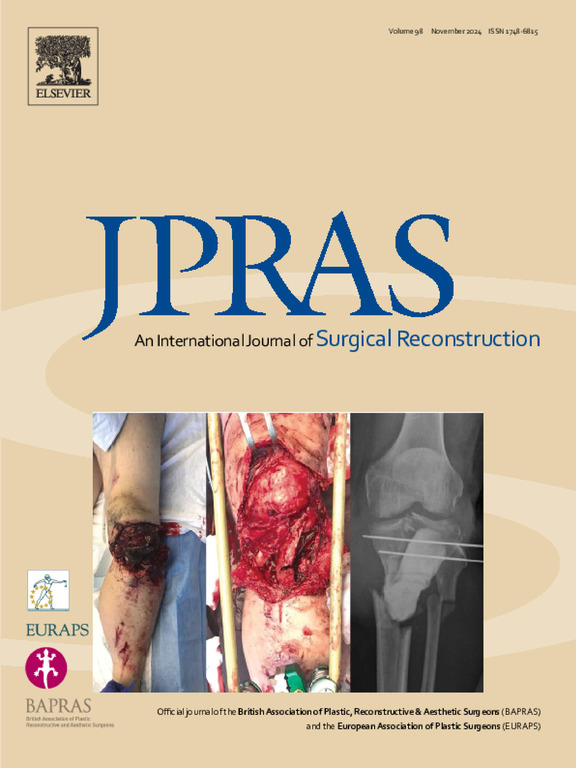外周血管病变动脉钙化的解剖顺序及其对游离皮瓣重建的意义
IF 2.4
3区 医学
Q2 SURGERY
Journal of Plastic Reconstructive and Aesthetic Surgery
Pub Date : 2025-05-13
DOI:10.1016/j.bjps.2025.05.004
引用次数: 0
摘要
外周血管疾病(PVD)患者的下肢游离组织移植(FTT)并发动脉钙化,可发生在游离皮瓣蒂血管和受体血管中。然而,没有研究检查在普通皮瓣蒂遇到钙化的可能性或该过程发生的解剖顺序。方法对行LE FTT的PVD患者行CT和XR影像学检查。采用专为心脏血管钙分析设计的软件,定量CT图像上躯干、上肢、骨盆和下肢皮瓣蒂的钙量。描述性统计用于鉴别受钙化影响最大的皮瓣血管。我们开发了一种新的评分系统(Qual Calc),通过检查平足x光片上血管钙化的定性存在来预测皮瓣蒂钙化的可能性。结果躯干椎弓根(肩胛骨下)的钙化率和体积均明显低于下肢椎弓根。LE瓣蒂最容易钙化,以旋股外侧动脉钙化最常见。Calc评分可高度预测上肢和下肢工作马皮瓣的定量钙容量。结论解剖上动脉钙化从下肢头侧向胸部发生。基于肩胛下系统的皮瓣受钙化的影响最小,在血管病变患者的肢体修复中,与基于大腿的皮瓣相比,它是一种更安全的重建选择。简单的足部x光片可用于预测皮瓣蒂钙化,准确度合理。本文章由计算机程序翻译,如有差异,请以英文原文为准。
The anatomical sequence of arterial calcification in peripheral vascular disease and its implications for free flap reconstruction
Introduction
Lower extremity (LE) free tissue transfer (FTT) in patients with peripheral vascular disease (PVD) is complicated by arterial calcification, which may occur in free flap pedicle vessels as well as recipient vessels. However, no studies have examined the likelihood of encountering calcification in common flap pedicles or the anatomical sequence in which this process occurs.
Methods
Computed tomography (CT) and x-ray (XR) imaging were obtained in PVD patients undergoing LE FTT. Using software designed for cardiac vessel calcium analysis, calcium volume was quantified in flap pedicles of the trunk, upper extremity, pelvis, and lower extremity on CT images. Descriptive statistics were used to identify flap vessels most affected by calcification. A novel scoring system (Qual Calc) was developed to predict the likelihood of flap pedicle calcification by examining the qualitative presence of vascular calcification on plain foot XR.
Results
Trunk pedicles (subscapular) showed statistically significantly lower calcification rates and volumes than lower extremity pedicles. LE flap pedicles were most likely to be calcified, with the lateral femoral circumflex artery being the most frequently calcified. Qual Calc score was highly predictive of quantified calcium volume in workhorse flaps of the upper and lower extremity.
Conclusion
Arterial calcification proceeds anatomically from the lower extremity cephalad towards the chest. Flaps based on the subscapular system are least affected by calcification and represent a safer reconstructive choice than thigh-based flaps for limb salvage in vasculopathic patients. Simple foot x-rays can be used to predict flap pedicle calcification with a reasonable degree of accuracy.
求助全文
通过发布文献求助,成功后即可免费获取论文全文。
去求助
来源期刊
CiteScore
3.10
自引率
11.10%
发文量
578
审稿时长
3.5 months
期刊介绍:
JPRAS An International Journal of Surgical Reconstruction is one of the world''s leading international journals, covering all the reconstructive and aesthetic aspects of plastic surgery.
The journal presents the latest surgical procedures with audit and outcome studies of new and established techniques in plastic surgery including: cleft lip and palate and other heads and neck surgery, hand surgery, lower limb trauma, burns, skin cancer, breast surgery and aesthetic surgery.

 求助内容:
求助内容: 应助结果提醒方式:
应助结果提醒方式:


